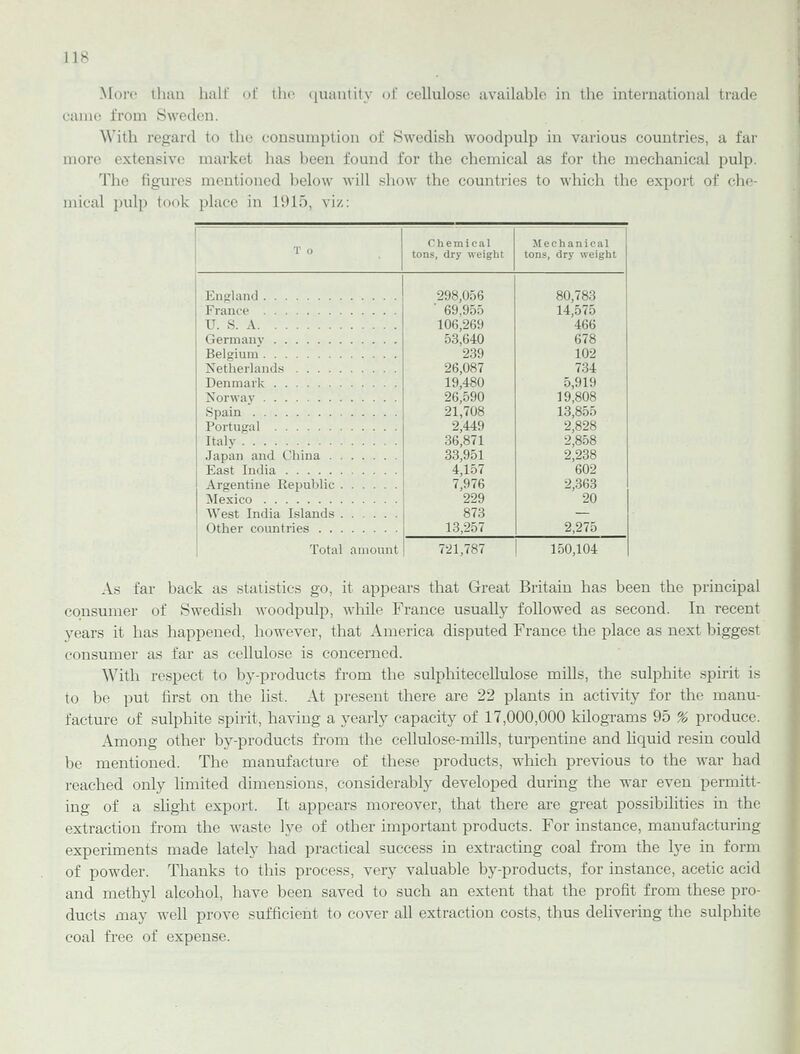
Full resolution (JPEG) - On this page / på denna sida - Wood pulp

<< prev. page << föreg. sida << >> nästa sida >> next page >>
Below is the raw OCR text
from the above scanned image.
Do you see an error? Proofread the page now!
Här nedan syns maskintolkade texten från faksimilbilden ovan.
Ser du något fel? Korrekturläs sidan nu!
This page has never been proofread. / Denna sida har aldrig korrekturlästs.
More than half of the quantity of cellulose available in the international trade
came from Sweden.
With regard to the consumption of Swedish woodpulp in various countries, a far
more extensive market has been found for the chemical as for the mechanical pulp.
The figures mentioned below will show the countries to which the export of
chemical pulp took place in 1915, viz:
T o Chemical tons, dry weight Mechanical tons, dry weight
! England 298,056 80,783
1 France 69,955 14,575
U. 8. A 106,269 466
Germany 53,640 678
Belgium 239 102
Netherlands 26,087 734
Denmark 19,480 5,919
Norway 26,590 19,808
! Spain 21,708 13,855
Portugal 2,449 2,828
Italy 36,871 2,858
Japan and China 33,951 2,238
East India 4,157 602
Argentine Republic 7,976 2,363
Mexico 229 20
West India Islands 873 —
Other countries 13,257 2,275
Total amount 721,787 150,104
As far back as statistics go, it appears that Great Britain has been the principal
consumer of Swedish woodpulp, while France usually followed as second. In recent
years it has happened, however, that America disputed France the place as next biggest
consumer as far as cellulose is concerned.
With respect to by-products from the sulphitecellulose mills, the sulphite spirit is
to be put first on the list. At present there are 22 plants in activity for the
manufacture of sulphite spirit, having a yearly capacity of 17,000,000 kilograms 95 % produce.
Among other by-products from the cellulose-mills, turpentine and liquid resin could
be mentioned. The manufacture of these products, which previous to the war had
reached only limited dimensions, considerably developed during the war even
permitting of a slight export. It appears moreover, that there are great possibilities in the
extraction from the waste lye of other important products. For instance, manufacturing
experiments made lately had practical success in extracting coal from the lye in form
of powder. Thanks to this process, very valuable by-products, for instance, acetic acid
and methyl alcohol, have been saved to such an extent that the profit from these
products may well prove sufficient to cover all extraction costs, thus delivering the sulphite
coal free of expense.
<< prev. page << föreg. sida << >> nästa sida >> next page >>